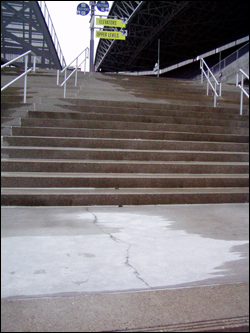When it rains in Seattle—as, of course, it does only four or five seasons a year—it sometimes rains inside Seahawks Stadium. Not on the field. In the locker rooms, public spaces, and offices. “We’ve had to put big waste buckets on the floor to catch the drips,” a stadium worker says. “We had them [buckets] all around the office.”
Altogether, according to a January state stadium inspection report, the $461 million house that billionaire Paul Allen built has 52 mostly water-related “issues.” They include dripping, seepage, pooling, poor drainage, slippery surfaces, faulty caulking, and expansion-joint leaks. Cracked concrete is apparent throughout the facility, built mainly at taxpayer expense. As a result, state officials say, Allen now stands in breach of his construction agreement. In a Jan. 28 letter, the state threatened to pursue “other remedies,” such as legal action, if Allen failed to properly patch the football facility.
Among the dozens of areas hit by drips or seepage are the Seagals locker room, the visitors’ locker room, the assistant coaches’ rest room, and Seahawks head coach Mike Holmgren’s office. The media interview room also has leaks, literally. Non-water issues include seat failures and problems with stadium venting and landscaping.
The dispute over the public facility, home field to Allen’s NFL Seattle Seahawks, comes at the same time the Microsoft co-founder is having problems at the Rose Garden basketball arena in Portland, which Allen owns and uses as the home for his Trail Blazers NBA franchise. On Friday, Feb. 27, America’s wealthiest sports mogul filed for bankruptcy in the wake of losses suffered from running the Portland sports and entertainment facility. Allen’s Oregon Arena Corp., which operates the $155 million complex across the Willamette River from downtown Portland, is seeking Chapter 11 protection and reorganization in federal bankruptcy court (the Trail Blazers team is not part of the action). Allen’s filing pegs OAC’s debt at more than $100 million, with assets between $10 million and $50 million.
“Our plan is to emerge from this process a healthy and vibrant organization,” OAC President Steve Patterson said in a statement. Allen personally contributed $90 million to OAC the past 11 years to subsidize bond payments and has decided “to stop funding a losing business,” Patterson said. Allen wants to form another company, NewCo, to buy his OAC for $50 million. (Its true assets are worth twice that amount, claims the Portland Tribune.) Allen still owes bondholders more than $130 million.
In Seattle, Allen’s people say Seahawks Stadium’s own liquidity problem is “minor” and should be expected of a major facility just 20 months old. A Seattle Weekly tour of the stadium last week found lots of cracked concrete, at least some of it predictable due to the settling atop the former tide flat and earthquake zone south of Pioneer Square. The expansive Grand Stairs at the north entry, however, was very cracked, and stadium staffers say it’s a major source of leaks. “We’re right under the Grand Stairs,” said one. “When we have a heavy rain, it drips real good.”
Retired construction engineer Vince Koskela, who read the state report and has toured the site, thinks the stairs will have to be jackhammered apart to determine the root of the problem. By Koskela’s count, there are 48 offices and locker, training, storage, and electrical/mechanical rooms with overhead leaks. Eight rooms have water seeping up through cracks in the floor.
Koskela, whose self-appointed mission is to watchdog stadium issues, says water also streams down access ramps and floods luxury suites during medium rain. There is some corridor flooding, and caulking problems are worst on the west side of the stadium, where water entered a large hollow space and mildew has become a major concern.
“The Public Stadium Authority is preparing to sue First & Goal,” Koskela says he has learned, referring respectively to the state authority that runs the public football stadium and to Paul Allen’s management group, which leases the stadium for $850,000 a year. (The Seahawks, in turn, lease the stadium from First & Goal.) “The PSA is preparing to bring in another contractor to finish the project and then will turn that bill over to First & Goal.”
The stadium authority won’t confirm Koskela’s speculation about litigation, saying the stadium inspection report and its January letter to Allen speak for themselves. In the letter, PSA Executive Director Ann Kawasaki Romero said the stadium has been “experiencing numerous problems with water infiltration at various locations.” The PSA began complaining about the problem in September 2002, three months after the stadium opened, and says Allen’s group vowed all repairs would be completed by January 2004. The PSA says Allen has been formally notified of the warranty breach and must make all repairs by the end of June.
The stadium, publicly approved in 1997 by 36,780 votes out of 1.6 million, was advertised as a $430 million facility, with the public’s share capped at $300 million. Allen was required to pay $100 million, much of which came as a loan from the NFL, plus any added costs or overruns. He had earlier pegged the added costs at $30 million but last year officially reported those costs as $61 million. However, the full price of the stadium—with interest, debt from the old Kingdome, and other costs—tops $1 billion, almost all of it borne by taxpayers.
Ray Colliver, First & Goal’s design and construction director, acknowledges what he terms “minor items of water infiltration” and says tracking the leaks in a complex stadium structure “is demanding and at times frustrating.” In a letter responding to the PSA’s breach notice, he says that “most” problems should be covered by an extended warranty agreement. “We, more than anyone, want the facility to be properly finished and repaired, and will see that it is so.”








